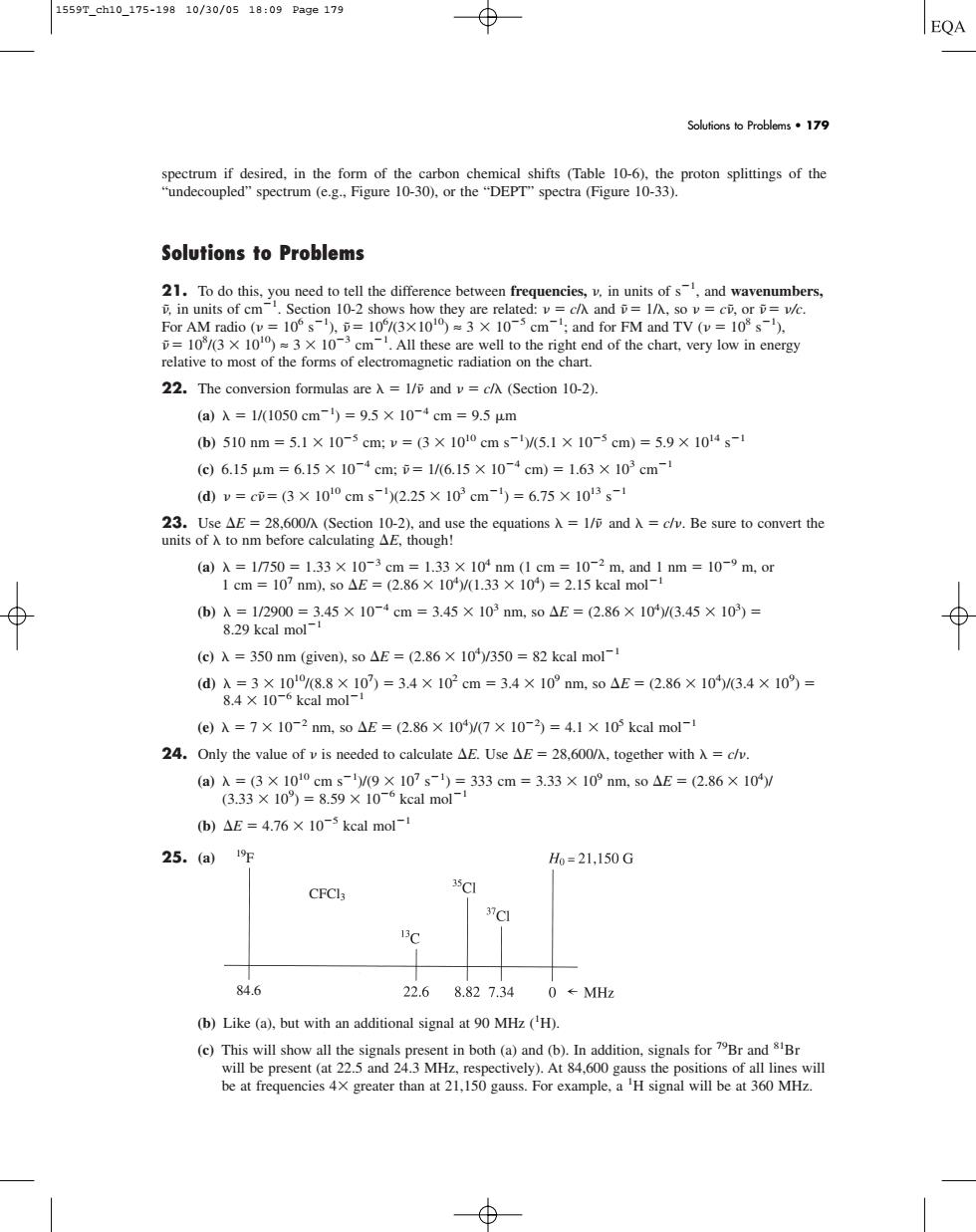正在加载图片...

1559T_ch10_175-19810/30/0518:09Pa9e179 ⊕ EQA Solutions to Problems.179 Solutions to Problems 21.To do 一o装owwo论】 03x10 22.The conversion formulas are=1/and v=c/A(Section 10-2). (a)λ=11050cm=9.5×10-4cm=9.5m (b)510nm=5.1×10-5cm:v=(3×100 cm s-l(5.1×10-5cm)=5.9×104s (⊙)6.154m=6.15×104cm=1/6.15×10-4cm)=1.63×103cm-1 (dv=cm=(3×10cms2.25×103cm=6.75×103s1 (aA=1/750=1.33×10-3cm=1.33×10nm(1cm=10-2m,and1nm=10-9m,or 1cm=10nm.s0△E=(2.86×101.33×10=2.15 kcal mol (e)=350 nm (given).so AE=(2.86x 10)/350 =82 keal mol- (d)A=3×1078.8×10=3.4×102cm=3.4×10°m,s0△E=(2.86×103.4×10%= 8.4×10-6 kcal mol (e)λ=7×10-2nm,s0△E=(2.86×10y7×10-=4.1×10 kcal mol- 24.Only the value ofvis needed to calculate AE.Use AE=28.600/A.together with=c/v. 3X0298×103m=3310m0E=6×10y (a)A=(6×100g (b)AE=4.76 x 10-5 keal mol-1 25.(a℉ H6=21,150G 37c1 84.6 22.68.827.340←MH (b)Like (a),but with an additional signal at 90 MHz (H). (e)This will show all the signals present in both (a)and (b).In addition,signals forBr andBr will be present (at 22.5 and 24.3 MHz. spectrum if desired, in the form of the carbon chemical shifts (Table 10-6), the proton splittings of the “undecoupled” spectrum (e.g., Figure 10-30), or the “DEPT” spectra (Figure 10-33). Solutions to Problems 21. To do this, you need to tell the difference between frequencies, , in units of s1 , and wavenumbers, ˜, in units of cm1 . Section 10-2 shows how they are related: c/ and ˜ 1/ , so c˜, or ˜ /c. For AM radio ( 106 s 1 ), ˜ 106 /(3
1010) ≈ 3
105 cm1 ; and for FM and TV ( 108 s 1 ), ˜ 108 /(3
1010) ≈ 3
103 cm1 . All these are well to the right end of the chart, very low in energy relative to most of the forms of electromagnetic radiation on the chart. 22. The conversion formulas are 1/˜ and c/ (Section 10-2). (a) 1/(1050 cm1 ) 9.5
104 cm 9.5
m (b) 510 nm 5.1
105 cm; (3
1010 cm s1 )/(5.1
105 cm) 5.9
1014 s 1 (c) 6.15
m 6.15
104 cm; ˜ 1/(6.15
104 cm) 1.63
103 cm1 (d) c˜ (3
1010 cm s1 )(2.25
103 cm1 ) 6.75
1013 s 1 23. Use E 28,600/ (Section 10-2), and use the equations 1/˜ and c/. Be sure to convert the units of to nm before calculating E, though! (a) 1/750 1.33
103 cm 1.33
104 nm (1 cm 102 m, and 1 nm 109 m, or 1 cm 107 nm), so E (2.86
104 )/(1.33
104 ) 2.15 kcal mol1 (b) 1/2900 3.45
104 cm 3.45
103 nm, so E (2.86
104 )/(3.45
103 ) 8.29 kcal mol1 (c) 350 nm (given), so E (2.86
104 )/350 82 kcal mol1 (d) 3
1010/(8.8
107 ) 3.4
102 cm 3.4
109 nm, so E (2.86
104 )/(3.4
109 ) 8.4
106 kcal mol1 (e) 7
102 nm, so E (2.86
104 )/(7
102 ) 4.1
105 kcal mol1 24. Only the value of is needed to calculate E. Use E 28,600/ , together with c/. (a) (3
1010 cm s1 )/(9
107 s 1 ) 333 cm 3.33
109 nm, so E (2.86
104 )/ (3.33
109 ) 8.59
106 kcal mol1 (b) E 4.76
105 kcal mol1 25. (a) (b) Like (a), but with an additional signal at 90 MHz (1 H). (c) This will show all the signals present in both (a) and (b). In addition, signals for 79Br and 81Br will be present (at 22.5 and 24.3 MHz, respectively). At 84,600 gauss the positions of all lines will be at frequencies 4
greater than at 21,150 gauss. For example, a 1 H signal will be at 360 MHz. CFCl3 84.6 19F Solutions to Problems • 179 1559T_ch10_175-198 10/30/05 18:09 Page 179